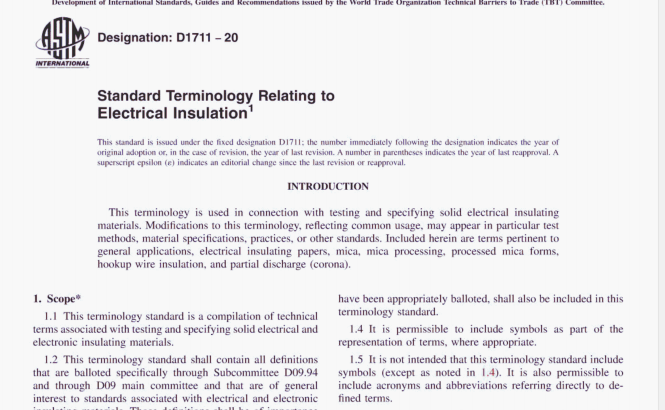ASTM D1711:20 pdf download.Standard Terminology Relating to Electrical Insulation.
resistance, surface, n- the ratio of the dc voltage applied to tWo electrodes (on the surface of a specimen) to the current between them. (2011)
DIscusston—(Some volume resistance is unavoidably included in the actual measurement.) Surface resistance is the reciprocal of surface conductance. (2011)
resistance, volume, n- the ratio of the dc voltage apI)lied to two electrodes (on or in a specimen) to the current in the volume of the specimen between the electrodes. (2011)
Discussion— -Volume resistance is the reciprocal of volume conductance. (2011)
resistivity, surface, n -the surface resistance multiplied by that ratio of specimen surface dimensions (width of electrodes defining the current path divided by the distance between electrodes) which transforms the measured resi stance to that obtained if the electrodes had formed the opposite sides of a square. (2011)
Discussion—Surface resistivity is expressed in ohms. It is popularly expressed also as ohmsquare (the size of the square is immaterial). Surface resistivity is the reciprocal of surface conductivity. (2011)
resistivity, volume, n—the volume resistance multiplied by that ratio of specimen volume dimensions (cross—sectional area of the electrodes divided by the distance between electrodes) which transforms the measured resistance to that resistance obtained if the electrodes had formed the opposite sides of a unit cube. (2011)
Discussion—Volume resistivity is usually expressed in ohm- centimetres (preferred) or in ohm-metres and is the reciprocal of volume conductivity. (2011)
rope-lay conductor, n—a conductor composed of a central core surn)unded by one or more layers of helically laid groups of strands. (2011)
Discussion— This kind of conductor differs from a concentric-lay conductor in that the main WIfCs are themselves stranded. In the niost common type of rope-lay conductor, all strands are the same size and the central core is a concentric-lay conductor. (2011)
rough or burred edge,n —a frayed or serrated edge usually 0.8 mm deep or greater, or an edge turned up or down as caused by trimming with scissors, and so forth, or by rubbing the edge against sandpaper, stone, and so forth. (2011)
round conductor flat cable,a flat cable made with parallel. round conductors in the same plane. (2011)
sample, one or more units of product taken from a lot without regard to the quality of the unit. (Also often termed lot sample). (2011)
sample size, u—the number of units of product taken to make up the sample. (2011)
Discussion— -Practice D3636 uses only lot sample sizes and not lot sizes since the discriminatory power of any sampling plan is independent essentially of the size of the lot. The sample size selected by the user for a given acceptable quality level (AQL) is optional depending upon the degree of protection desired by the user against the acceptance
of noncontonning lots. (2011)
ASTM D1711:20 pdf download
